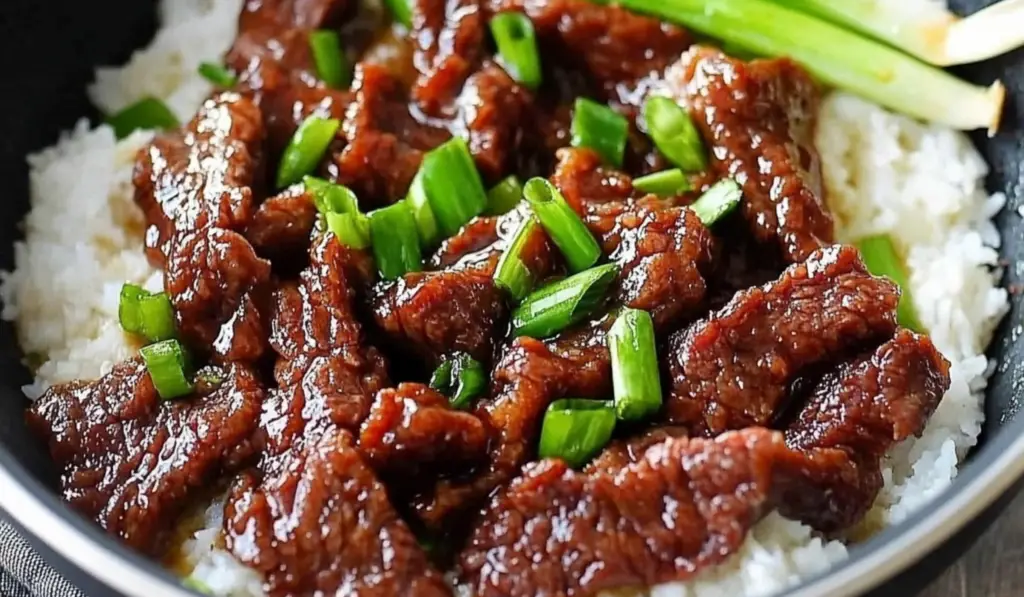Mongolian Beef is a dish that brings together the perfect balance of savory and sweet flavors, all wrapped in a sauce that is rich, glossy, and utterly satisfying. For many food lovers, this meal has become a staple for its bold flavors and the fact that it is quick to prepare, making it ideal for busy weeknights or casual dinner parties. This 30-Minute Mongolian Beef recipe takes all the elements you love about the dish and condenses them into a 30-minute preparation time without compromising on taste or quality. With tender, crispy steak, a caramelized sauce, and just the right amount of spice, it’s sure to delight your senses and become a regular in your meal rotation.

30-Minute Mongolian Beef: A Quick and Flavor-Packed Delight
Mongolian Beef is a dish that brings together the perfect balance of savory and sweet flavors, all wrapped in a sauce that is rich, glossy, and utterly satisfying. For many food lovers, this meal has become a staple for its bold flavors and the fact that it is quick to prepare, making it ideal for busy weeknights or casual dinner parties. This 30-Minute Mongolian Beef recipe takes all the elements you love about the dish and condenses them into a 30-minute preparation time without compromising on taste or quality. With tender, crispy steak, a caramelized sauce, and just the right amount of spice, it’s sure to delight your senses and become a regular in your meal rotation.
- Prep Time: 15 minutes
- Cook Time: 15 minutes
- Total Time: 30 minutes
- Yield: 4 servings 1x
- Category: Main Course
- Method: Pan-Frying
- Cuisine: Asian, Chinese-American
Ingredients
- 1½ pounds sirloin steak, 1-inch thick: Sirloin is the preferred cut for this recipe, as it offers a good balance of tenderness and flavor, and it cooks quickly. You can substitute it with other cuts such as flank steak or ribeye, but be sure to slice it thinly to ensure quick cooking and maximum flavor.
- ⅓ cup cornstarch: Cornstarch is key to achieving the crispy texture on the steak. It coats the beef slices, allowing them to fry to golden perfection while also helping to thicken the sauce later on.
- ¼ cup canola oil: Canola oil works well for frying because it has a high smoke point and neutral flavor. You could also use vegetable oil or peanut oil if desired.
- ¼ teaspoon salt: A pinch of salt will help bring out the flavors in the beef and balance the sweetness of the sauce.
- 1 tablespoon fresh grated ginger: Ginger adds a lovely warmth and slight peppery note to the sauce, balancing the sweetness of the brown sugar and the saltiness of the soy sauce.
- 4 tablespoons garlic, minced: Garlic is another aromatic ingredient that enhances the overall flavor, infusing the sauce with a rich, savory depth.
- Red pepper flakes or chili oil: This ingredient is optional, but it gives the dish a nice spicy kick. You can add as much or as little as you prefer, depending on how spicy you want the dish to be.
- ⅓ cup reduced sodium tamari sauce (for a gluten-free version), or soy sauce: Tamari is a great alternative to soy sauce for anyone following a gluten-free diet, but regular soy sauce can also be used for a more traditional flavor.
- ½ cup water: The water helps to thin out the sauce and allows the flavors to meld together.
- ⅓ cup brown sugar: Brown sugar brings the necessary sweetness to the dish, and its rich molasses flavor complements the savory notes of the sauce.
- 8 stalks scallions, green parts only, cut into 2-inch pieces: Scallions not only add a beautiful pop of green color to the dish but also provide a fresh, crisp bite that contrasts nicely with the tender beef and thick sauce.
Instructions
- Prepare the Steak: Start by slicing the sirloin steak into ¼-inch thick slices. Lay the slices flat on a cutting board and cover them with plastic wrap. Using a meat pounder, gently flatten each slice. This step tenderizes the beef and helps it cook evenly. Once flattened, place the slices of beef in a Ziploc bag and add the cornstarch. Seal the bag and shake it well to ensure that the beef is fully coated with the cornstarch. This step helps to create the crispy crust on the beef when it’s fried and also thickens the sauce as it simmers later.
- Cook the Beef: Heat a large frying pan or skillet over medium-high heat and pour in the canola oil. Once the oil is hot and shimmering, carefully add the coated beef slices to the pan. Make sure not to overcrowd the pan; you want to cook the beef in a single layer to achieve that crispy texture. Cook the beef for about 30 seconds per side, or until each piece is golden and slightly crispy. You may need to cook the steak in batches, depending on the size of your pan. After the beef is cooked, remove it from the pan and set it aside on a plate. Lightly sprinkle with salt to enhance the flavor.
- Sauté the Aromatics: In the same pan, add the freshly grated ginger and minced garlic. Sauté these ingredients for about 10-15 seconds, stirring constantly, until they become fragrant. If you’re adding chili oil or red pepper flakes for a bit of heat, this is the perfect time to do so. The ginger and garlic will infuse the oil, creating a rich, aromatic base for the sauce.
- Make the Sauce: Stir in the tamari sauce (or soy sauce), water, and brown sugar. Allow the mixture to come to a boil, stirring occasionally. The brown sugar will dissolve, and the sauce will begin to thicken slightly. You’ll notice that the sauce takes on a glossy sheen as it cooks, thanks to the cornstarch from the beef. Continue to cook for a couple of minutes, allowing the flavors to meld together.
- Combine the Beef and Sauce: Once the sauce is bubbling and the sugar has dissolved, return the cooked beef to the pan. Stir the beef into the sauce, making sure each piece is coated in the flavorful glaze. Let the beef simmer in the sauce for another 20-30 seconds, allowing the cornstarch to thicken the sauce further. The sauce should be silky and cling to the beef, creating a deliciously sticky coating.
- Finish with Scallions: Turn off the heat and fold in the green onion pieces. The green onions will add a burst of fresh, crisp flavor that balances the rich, savory sauce. Stir everything together, and your Mongolian Beef is now ready to be served.
Notes
- Beef Cut: If you don’t have sirloin on hand, you can use flank steak or ribeye for a slightly different flavor. Flank steak is leaner but still tender when sliced thin, while ribeye will provide more marbling and richness. Just make sure the beef is sliced thinly to ensure even cooking.
- Tamari vs. Soy Sauce: Tamari is a fantastic choice if you’re following a gluten-free diet, but if you don’t need to worry about gluten, regular soy sauce will work just as well. You can also experiment with low-sodium soy sauce to reduce the salt content in the dish.
- Sweeteners: Brown sugar is the classic choice for Mongolian Beef, but if you prefer a different type of sweetness, try substituting with honey, maple syrup, or coconut sugar. Each of these alternatives will bring its own unique flavor to the sauce.
- Vegetables: For a more balanced dish, you can add vegetables like bell peppers, snap peas, or carrots to the pan. These vegetables will add color, texture, and extra nutrition. Simply sauté them along with the garlic and ginger for a couple of minutes before adding the sauce.
What makes this Mongolian Beef particularly appealing is its versatility and speed. You can make it in a fraction of the time it would take to order takeout, and it’s just as flavorful, if not more. Imagine sinking your teeth into pieces of steak that are crispy on the outside yet tender on the inside, all coated in a savory-sweet sauce made with soy sauce (or tamari for a gluten-free option), brown sugar, and a hint of ginger. Topped with a burst of fresh green onions, this dish satisfies all your cravings in less time than it takes to cook rice.
Mongolian Beef is ideal for those who enjoy bold, comforting flavors but don’t want to spend hours in the kitchen. You’ll be able to create a restaurant-quality meal at home with minimal effort, making it the perfect option for a satisfying dinner that’s sure to impress. Whether you’re serving it over steamed rice, rice noodles, or even in lettuce wraps, this dish is guaranteed to bring smiles to the table.
Ingredients:
To prepare this 30-Minute Mongolian Beef, you’ll need the following ingredients:
- 1½ pounds sirloin steak, 1-inch thick: Sirloin is the preferred cut for this recipe, as it offers a good balance of tenderness and flavor, and it cooks quickly. You can substitute it with other cuts such as flank steak or ribeye, but be sure to slice it thinly to ensure quick cooking and maximum flavor.
- ⅓ cup cornstarch: Cornstarch is key to achieving the crispy texture on the steak. It coats the beef slices, allowing them to fry to golden perfection while also helping to thicken the sauce later on.
- ¼ cup canola oil: Canola oil works well for frying because it has a high smoke point and neutral flavor. You could also use vegetable oil or peanut oil if desired.
- ¼ teaspoon salt: A pinch of salt will help bring out the flavors in the beef and balance the sweetness of the sauce.
- 1 tablespoon fresh grated ginger: Ginger adds a lovely warmth and slight peppery note to the sauce, balancing the sweetness of the brown sugar and the saltiness of the soy sauce.
- 4 tablespoons garlic, minced: Garlic is another aromatic ingredient that enhances the overall flavor, infusing the sauce with a rich, savory depth.
- Red pepper flakes or chili oil: This ingredient is optional, but it gives the dish a nice spicy kick. You can add as much or as little as you prefer, depending on how spicy you want the dish to be.
- ⅓ cup reduced sodium tamari sauce (for a gluten-free version), or soy sauce: Tamari is a great alternative to soy sauce for anyone following a gluten-free diet, but regular soy sauce can also be used for a more traditional flavor.
- ½ cup water: The water helps to thin out the sauce and allows the flavors to meld together.
- ⅓ cup brown sugar: Brown sugar brings the necessary sweetness to the dish, and its rich molasses flavor complements the savory notes of the sauce.
- 8 stalks scallions, green parts only, cut into 2-inch pieces: Scallions not only add a beautiful pop of green color to the dish but also provide a fresh, crisp bite that contrasts nicely with the tender beef and thick sauce.
Step-by-Step Instructions:
- Prepare the Steak: Start by slicing the sirloin steak into ¼-inch thick slices. Lay the slices flat on a cutting board and cover them with plastic wrap. Using a meat pounder, gently flatten each slice. This step tenderizes the beef and helps it cook evenly. Once flattened, place the slices of beef in a Ziploc bag and add the cornstarch. Seal the bag and shake it well to ensure that the beef is fully coated with the cornstarch. This step helps to create the crispy crust on the beef when it’s fried and also thickens the sauce as it simmers later.
- Cook the Beef: Heat a large frying pan or skillet over medium-high heat and pour in the canola oil. Once the oil is hot and shimmering, carefully add the coated beef slices to the pan. Make sure not to overcrowd the pan; you want to cook the beef in a single layer to achieve that crispy texture. Cook the beef for about 30 seconds per side, or until each piece is golden and slightly crispy. You may need to cook the steak in batches, depending on the size of your pan. After the beef is cooked, remove it from the pan and set it aside on a plate. Lightly sprinkle with salt to enhance the flavor.
- Sauté the Aromatics: In the same pan, add the freshly grated ginger and minced garlic. Sauté these ingredients for about 10-15 seconds, stirring constantly, until they become fragrant. If you’re adding chili oil or red pepper flakes for a bit of heat, this is the perfect time to do so. The ginger and garlic will infuse the oil, creating a rich, aromatic base for the sauce.
- Make the Sauce: Stir in the tamari sauce (or soy sauce), water, and brown sugar. Allow the mixture to come to a boil, stirring occasionally. The brown sugar will dissolve, and the sauce will begin to thicken slightly. You’ll notice that the sauce takes on a glossy sheen as it cooks, thanks to the cornstarch from the beef. Continue to cook for a couple of minutes, allowing the flavors to meld together.
- Combine the Beef and Sauce: Once the sauce is bubbling and the sugar has dissolved, return the cooked beef to the pan. Stir the beef into the sauce, making sure each piece is coated in the flavorful glaze. Let the beef simmer in the sauce for another 20-30 seconds, allowing the cornstarch to thicken the sauce further. The sauce should be silky and cling to the beef, creating a deliciously sticky coating.
- Finish with Scallions: Turn off the heat and fold in the green onion pieces. The green onions will add a burst of fresh, crisp flavor that balances the rich, savory sauce. Stir everything together, and your Mongolian Beef is now ready to be served.
Flavor Profile and Texture:
The first thing you’ll notice about this Mongolian Beef is the perfect balance between savory, sweet, and slightly spicy flavors. The soy sauce (or tamari) brings a deep umami richness, while the brown sugar adds a sweetness that is essential to the dish. The ginger and garlic contribute layers of aromatic depth, while the chili oil or red pepper flakes give the dish a pleasant kick of heat that lingers without overpowering the other flavors.
The texture is equally delightful. The cornstarch coating on the beef creates a crispy crust, while the inside remains juicy and tender. As the beef simmers in the sauce, it absorbs the flavors while keeping its crispiness intact. The scallions, added at the end, add a refreshing crunch that contrasts beautifully with the silky sauce, enhancing the overall texture of the dish.
Ingredient Substitutions and Variations:
While this recipe is delicious as written, there are plenty of ways you can tweak it based on your preferences or what ingredients you have on hand.
- Beef Cut: If you don’t have sirloin on hand, you can use flank steak or ribeye for a slightly different flavor. Flank steak is leaner but still tender when sliced thin, while ribeye will provide more marbling and richness. Just make sure the beef is sliced thinly to ensure even cooking.
- Tamari vs. Soy Sauce: Tamari is a fantastic choice if you’re following a gluten-free diet, but if you don’t need to worry about gluten, regular soy sauce will work just as well. You can also experiment with low-sodium soy sauce to reduce the salt content in the dish.
- Sweeteners: Brown sugar is the classic choice for Mongolian Beef, but if you prefer a different type of sweetness, try substituting with honey, maple syrup, or coconut sugar. Each of these alternatives will bring its own unique flavor to the sauce.
- Vegetables: For a more balanced dish, you can add vegetables like bell peppers, snap peas, or carrots to the pan. These vegetables will add color, texture, and extra nutrition. Simply sauté them along with the garlic and ginger for a couple of minutes before adding the sauce.
Serving Suggestions:
Mongolian Beef is incredibly versatile when it comes to how you serve it. The classic approach is to serve it over steamed white rice. The rice soaks up the savory sauce, making each bite more satisfying. However, if you’re looking for a more filling dish, rice noodles are another excellent option. The chewy noodles hold the sauce beautifully and add a comforting texture to the meal.
For those looking for a low-carb or lighter option, you can serve the Mongolian Beef in lettuce wraps. The crispness of the lettuce provides a refreshing contrast to the rich, saucy beef, and the wraps make for a fun, hands-on way to enjoy the dish.
For a complete meal, consider adding a side of sautéed or steamed vegetables like bok choy, broccoli, or snap peas. These vegetables complement the flavors of the beef while adding more color and texture to your plate. You can also serve the dish with a simple cucumber salad to add a cool, tangy contrast to the warm, savory beef.

Final Thoughts:
This 30-Minute Mongolian Beef is the epitome of comfort food with a modern twist. With its crispy beef, savory sauce, and just the right amount of sweetness, it’s a dish that’s sure to impress anyone at your table. Plus, with a cooking time of just 30 minutes, it’s perfect for when you want something quick but flavorful. Whether you serve it over rice, noodles, or in lettuce wraps, this dish will satisfy your cravings and become a favorite in your home cooking repertoire. So, grab your ingredients, fire up your skillet, and treat yourself to a plate of delicious Mongolian Beef tonight!




